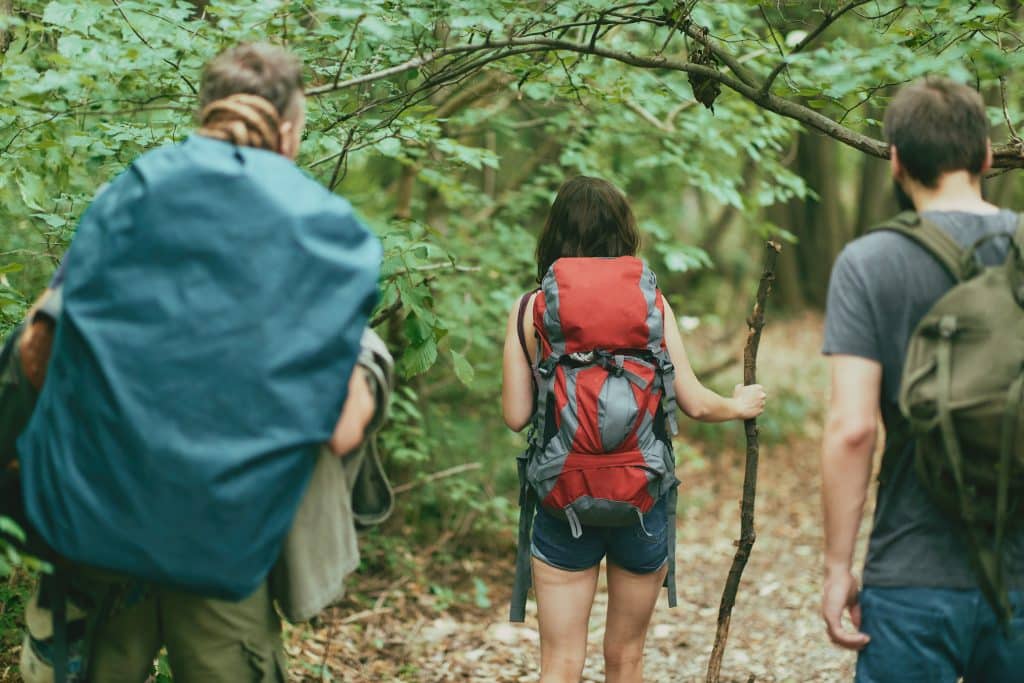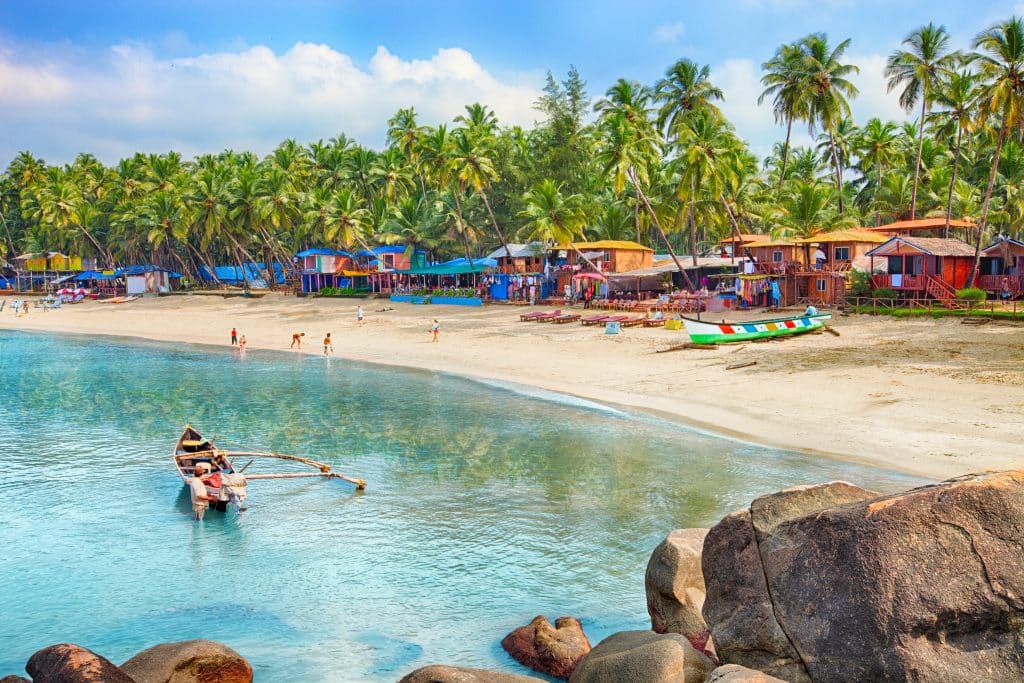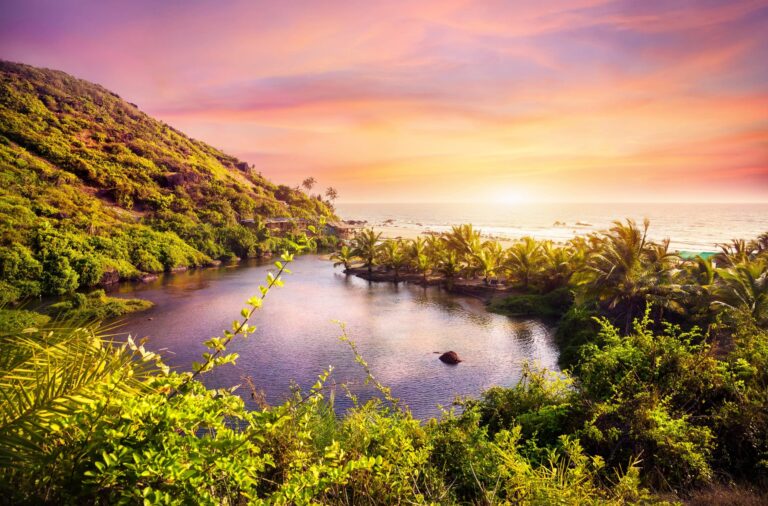In the South end of India, amidst the palm trees and spicy curries, with an evident leftover of Portuguese rule, lies the historic beachside stretch of Goa. This old heaven – the last stop on the hippie trail – gained huge popularity in the 60s and 70s, becoming known for its peaceful nature, expansive beaches and psychedelic trance music.
You know those places that you desperately want to visit, but your dad sits you down and says, “I’m sorry, it was just better in the old days”, well this is one of those. Goa lives in the past – constantly looking back at a time where it was less touristy, less busy and freer. Well, here I currently sit, with a small moped and a chai tea, on the Goan beach of Anjuna. Does this place have any remnants of what it once was? Let’s take a walk down memory lane and see what all the fuss is about.
To stay current on everything important happening in the industry, as well as gain access to deals on cannabis flowers, vapes, edibles, and much more (various cannabinoids to choose from), make sure to subscribe to The Cannadelics Weekly Newsletter. Enjoy responsibly!
Goa, India
Before we delve into Goa’s more recent history, let’s first go further back in time. As with any hippie hotspot, there will be a reason why so many people found something special in this south Indian district. First of all, Goa is near the bottom of India – which is the 7th largest country in the world, and has the 2nd biggest population (around 1.4 billion people).
Goa, specifically, has around 1.4 million people living on its 3700km land. The beaches are famous for being massively long and flat, and the sunsets – looking out to the Arabian Ocean – are breathtaking. Many people come to Goa and wonder why it’s so different from the rest of India.
There is a lot of greenery, with coconut trees rising higher than you’ve ever seen, and the smell of sea water and Goan fish curry in the air. But that’s not the main difference. One huge contributor is the evident remnants of Portuguese rule, which began in 1510 – lasting 450 years. The churches and old buildings have an obvious European inspiration, which feels odd to see in an Indian district, but it definitely adds to its beauty. Britannica writes more on how the Portuguese took power of Goa:
“The city was attacked in March 1510 by the Portuguese under Afonso de Albuquerque. The city surrendered without a struggle, and Albuquerque entered it in triumph. Three months later Yūsuf ʿĀdil Khan returned with 60,000 troops, forced the passage of the ford, and blockaded the Portuguese in their ships… In November, Albuquerque returned with a larger force and… recaptured the city… Goa became the capital of the whole Portuguese empire in Asia.”
The age of ‘Golden Goa’ is actually known to be long before the hippies turned up in the late 60s, but actually in the period between the 1500s and 1600s. This was a period when the voyages of Portugal began, opening up a western Europe sea route to Asia. During this century, the Portuguese held a monopoly over the Indian ocean. Goa was used as the perfect sailing point after or before a long and sometimes tumultuous journey. It’s important to consider, of course, that the growth of any empire is not one to be celebrated. Whilst Portuguese rule allowed for much of Goan culture to remain the same, it was still an example of the superiority complex that Europe had. Nonetheless, you cannot deny the beauty of this place. The Goan tropics, Indian food, and a peppering of ancient Portuguese architecture is a recipe for wonder. Outlook India perfectly summarises the experience of the place:
“450 years of Portuguese occupation have left an indelible impact on the culture, cuisine and architecture of the tiny state, and gives this tourist paradise a distinct, hard-to-quantify flavour.”
Goa managed to avoid British rule – which dominated the majority of India – due to being part of the Portuguese empire. In 1961, after a long and arduous battle, they gained their independence. It was a great day for the Goan people. However, a new kind of colonisation was about to begin. The hippies were coming.
Hippie Trail
If you ask anyone about Goa’s history, you’ll most likely hear about the hippie culture that was growing in the 60s and 70s. Young people, travelling by hippie van from the US or Europe, lying on a beach enjoying psychedelic trance and recreational drugs. The world had experienced the war to end all wars and were still living in the aftermath. In America, the civil rights movement and the Vietnam war were dominating proceedings.

After a lifetime of wars and conflicts, leaving home and embarking on the hippie trail felt like a chance to breathe. The hippie trail was a driving route which took passengers from Europe to Asia. Whilst airlines and flights were gaining traction, the high prices made them nearly impossible. Therefore, buses around the world became popular. In 1957, the Indiaman bus was organized from London. It took 20 passengers in 2 months all the way to Kolkata, India, with a return price of only 65 pounds. It was this route, and many others like it, that began the hippie trail. Groups in their VW buses – Bob Dylan, the Beatles and Hendrix blaring – would drive themselves all the way through Europe, into the Middle East, and into Asia. History Extra writes:
“For some, it was… an expression of 1960s counterculture – and for many of those the use of drugs including opium or hash was a key part of the experience. For others, it was just a great adventure: a chance to travel cheaply and encounter unfamiliar cultures… As Rory MacLean notes in Magic Bus, his 2006 history of the phenomenon, they comprised “the first movement of people in history travelling to be colonized rather than to colonize”
The hippie trail would often end in the south part of India. This is why Goa was such a hippie haven. After a journey that had taken months, perhaps years, it was a time to unwind and – for many – to settle here.
Goa and the Hippies
You only have to visit Goa to understand why many people would have settled here. The prices are cheap now, so to think how low they would have been in the 60s and 70s would be shocking. But not only that, the peacefulness and spirituality of the place is undeniable. After months of travelling round the world, ending up on one of the many beaches of Goa must’ve felt like quite God had spat you into heaven.
It was eventually seen as the end point of the trail – like a rising star in the distance, keeping those travelling on course to paradise. However, the movement was as much about the people travelling as it was about the place. For the first time in a long time, it was becoming fashionable to want to explore the world and learn from other cultures. With this came a desire for global connection, an end to conflict and a beginning of a different way of seeing.
Of course, as is often the case, this movement also brought with it an exploration of psychedelic drugs. Anjuna, one of the popular beaches, was known to have easy access to LSD, hash and heroin – partly due to a lack of a police station. Plus, these drugs were not even declared illegal in the area until the 70s. In addition, opium and other substances had been traded freely through Goa during Portuguese rule in the 18th and 19th centuries, meaning there was an abundance of the stuff. Alongside the drugs came the music. Vice writes:
“Goa’s music scene also grew from guitar-strumming psychedelic rock, to becoming the first Indian state to have an electronic music scene. By the mid-80s, the love and peace motives of the hippie movement began slowly fading away, as the scene gave way to psychedelic trance… And as we descended into the 90s, Goa’s psychedelic raves went from an underground scene to worldwide recognition”
As with any golden age, it must eventually come to an end. As Goa became globally recognized, and flights became cheaper, the alternative movement of the past was taken over by young ravers looking to get ‘messy’. Beaches became overpopulated with people and bars, the police began to crack down on drug use and the locals began playing on the ‘hippie history’ with hollow and inauthentic venues. The real reason and purpose behind the movement in the 60s and 70s was gone.
Goa Now
It is very easy to say that Goa will never be the same, and in a sense, it won’t be. Even when you enter the airport now, you’re blinded by casino advertisements and pictures of semi-nude women. It is now seen by many as a place to leave your morality at the door. For those who wish to find the hippie culture of the 70s, it is nearly impossible, as almost everywhere is commercialized. Nonetheless, not all hope is lost. No time can be like another.

The coconut trees still grow, the food is still gorgeous and the music still plays – even if many bars are limited to a 10pm cut off time. We cannot go back, but we can look forward. With the world constantly changing, new conflicts looming, perhaps Goa is due another golden era sometime soon. As I sit here, in the old hippie haven of Anjuna beach, I can still taste the history in the air and am ready to enjoy making some more of it.
Hello readers! We appreciate you joining us at Cannadelics.com, a top choice news platform for independent coverage of the growing cannabis and psychedelics landscapes of today. Come by the site whenever possible for updates on current and world-changing events, and head over to the Cannadelics Weekly Newsletter, so you’re always up on what’s going down.
